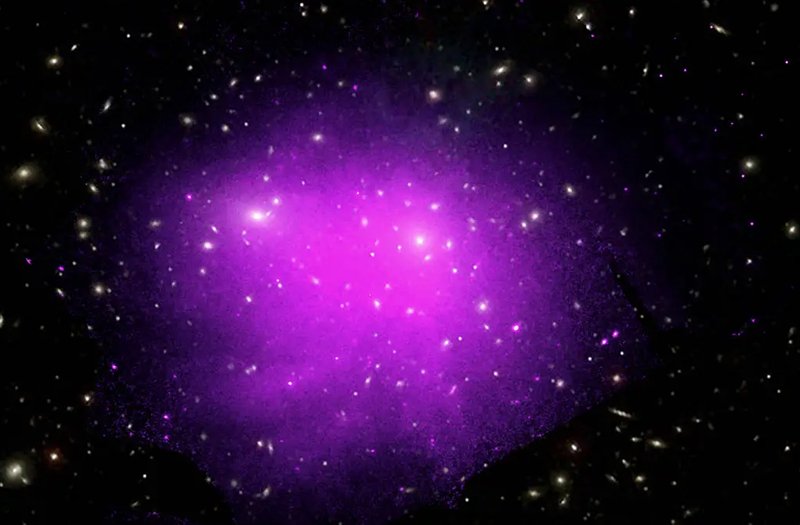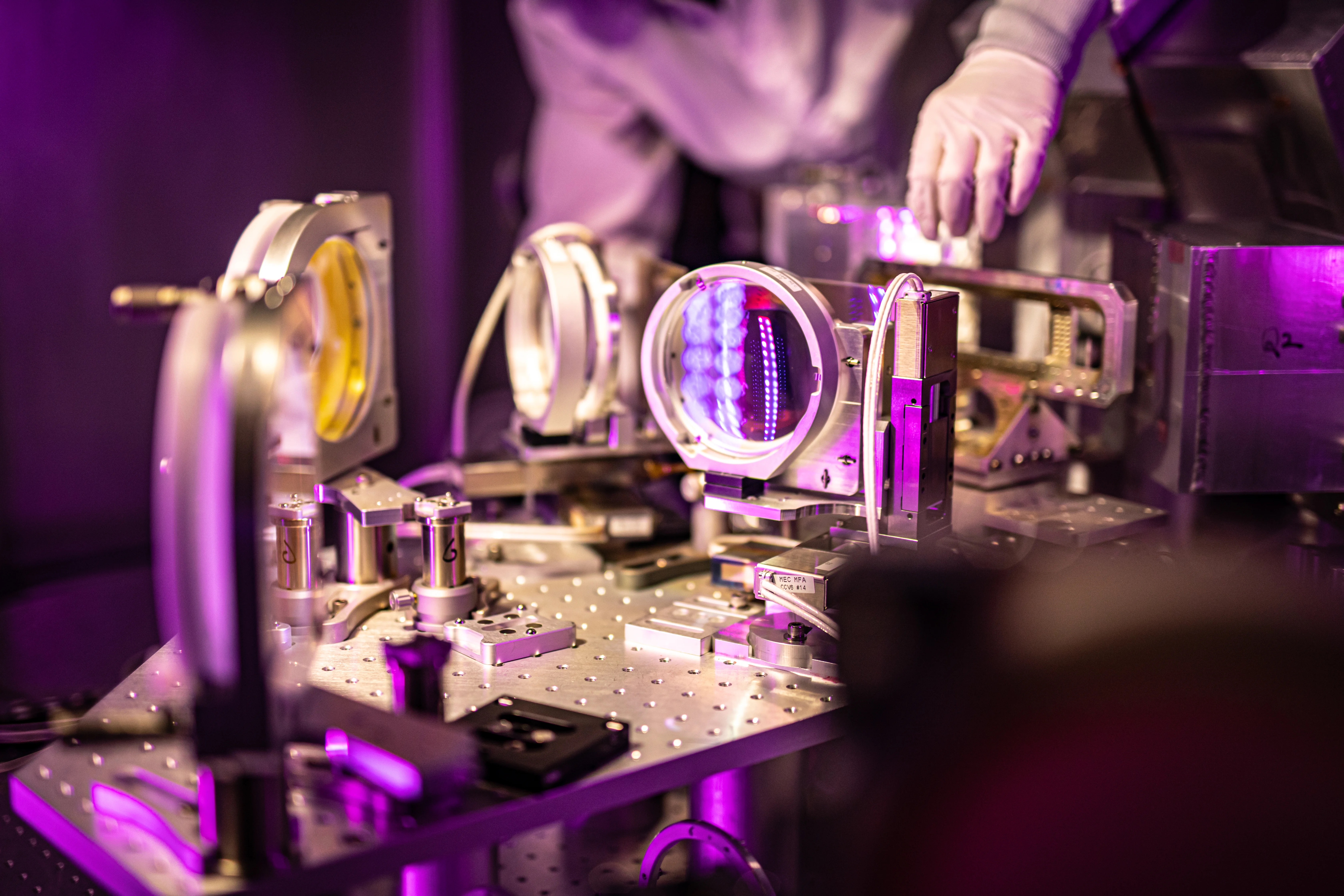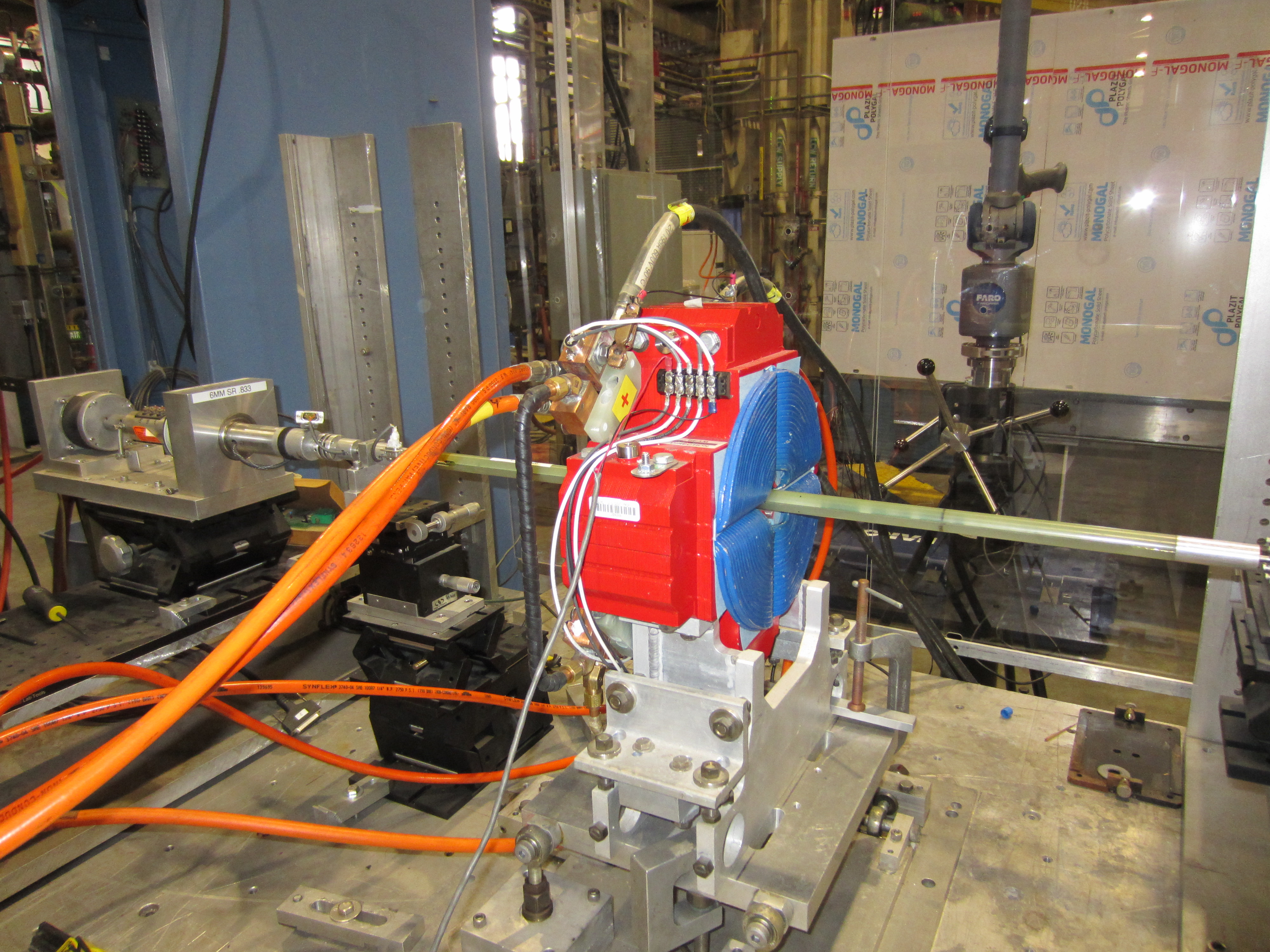Improvements to the lab’s “electron camera” use AI and “time stamping” to help reveal nature’s speedy processes more accurately.
Tag: SLAC National Accelerator Laboratory
La cámara más grande en la historia de la astronomía ya está lista para retratar al Universo
La cámara digital astronómica más grande del mundo ya está terminada. Una vez que se encuentre instalada en el telescopio en Chile, la llamada Cámara LSST será capaz de recolectar una cantidad de datos sin precedentes sobre nuestro Universo, proporcionando nuevos conocimientos acerca de todo lo que hay allá afuera, desde la energía oscura hasta los asteroides.
Construction of Largest Digital Camera Ever Built for Astronomy Completed
The world’s largest digital camera for astronomy is complete. Once in place on a telescope in Chile, the LSST Camera will gather an unprecedented amount of data about our Universe, yielding new insights into everything from dark energy to asteroids.
SLAC completes construction of the largest digital camera ever built for astronomy
After two decades of work, scientists and engineers at the Department of Energy’s SLAC National Accelerator Laboratory and their collaborators are celebrating the completion of the Legacy Survey of Space and Time (LSST) Camera.
A battery’s hopping ions remember where they’ve been
Scientists discover that ions hopping through a battery electrolyte can reverse direction in response to a jolt of voltage and briefly return to their previous positions – .the first indication that the ions remembered, in a sense, where they had just been.

Testing the Evolution of the Universe with Galaxy Clusters
100 billion – there are at least that many stars in our Milky Way. It seems like an unimaginable number. Yet astrophysicists study structures in our universe that are far bigger than galaxies alone.
El Observatorio Rubin impulsará una nueva era en misiones espaciales sin salir de la tierra
El Observatorio Vera C. Rubin ayudará a los científicos a identificar objetivos intrigantes para dar prioridad a futuras misiones espaciales, mediante la detección de millones de nuevos objetos en el Sistema Solar y revelar, con el mayor detalle jamás visto, el contexto más amplio en el que existen.
Rubin Observatory will Inspire a New Era in Space Missions without Ever Leaving the Ground
Vera C. Rubin Observatory will help scientists identify intriguing targets to prioritize for future space missions by detecting millions of new Solar System objects, and by revealing — in more detail than we’ve ever seen — the broader context in which these objects exist.

Renewed support for high power laser facilities will benefit discovery science and inertial fusion energy research at SLAC
LaserNetUS funding will allow scientists to take advantage of the Matter in Extreme Conditions instrument and ultrabright X-rays at the Linac Coherent Light Source to explore fundamental plasma science and inertial fusion energy research and technology.
SLAC fires up the world’s most powerful X-ray laser: LCLS-II ushers in a new era of science
The newly upgraded Linac Coherent Light Source (LCLS) X-ray free-electron laser (XFEL) at the Department of Energy’s SLAC National Accelerator Laboratory successfully produced its first X-rays, and researchers around the world are already lined up to kick off an ambitious science program.
Jim Sebek wins 2023 Lytle Award for decades of synchrotron problem solving and dedication
Jim Sebek, an electrical engineer and physicist at the Stanford Synchrotron Radiation Lightsource (SSRL) at the Department of Energy’s SLAC National Accelerator Laboratory, will receive this year’s Farrel W. Lytle Award for countless contributions towards building, maintaining and operating the synchrotron for nearly four decades.
‘Computer vision’ reveals unprecedented physical and chemical details of how a lithium-ion battery works
Looking at X-ray movies with computer vision gives researchers an incredible new view of how nanoparticles in a lithium-ion battery electrode work during charging and discharging.
Department of Energy Announces $73 Million for Basic Research to Accelerate the Transition from Discovery to Commercialization
Today, the U.S. Department of Energy (DOE) announced $73 million in funding for eleven projects which focus on the goal of accelerating the transition from discovery to commercialization of new technologies that will form the basis of future industries.
SLAC researchers take important step toward developing cavity-based X-ray laser technology
Researchers used diamond mirrors to guide X-ray laser pulses around a rectangular racetrack inside a vacuum chamber. It’s an important step toward developing cavity-based X-ray free-electron lasers, or CBXFELs, to make X-ray laser pulses brighter and cleaner – more like regular lasers are today.
New catalyst could dramatically cut methane pollution from millions of engines
Today’s catalysts for removing unburnt methane from natural-gas engine emissions are either inefficient at low, start-up temperatures or break down at higher operating temperatures. A new single-atom catalyst solves both these problems and removes 90% of the methane.
A foundation that fits just right gives superconducting nickelates a boost
Researchers at SLAC and Stanford found a way to make thin films of an exciting new nickel oxide superconductor that are free of extended defects. This improved the material’s ability to conduct electricity with no loss and revealed that it’s more like superconducting cuprates than previously thought.
Humidity – not just light – causes color degradation in historical paintings, researchers discover
When you look at a painting in a museum, the colors that you see are likely less bright than they were originally, something that had previously been attributed mainly to light exposure. Now, researchers have discovered a new cause of color degradation: humidity.
Scientists capture elusive chemical reaction using enhanced X-ray method
Researchers at SLAC National Accelerator Laboratory captured one of the fastest movements of a molecule called ferricyanide for the first time by combining two ultrafast X-ray spectroscopy techniques. They think their approach could help map more complex chemical reactions like oxygen transportation in blood cells or hydrogen production using artificial photosynthesis.

Researchers capture elusive missing step in the final act of photosynthesis
Photosynthesis plays a crucial role in shaping and sustaining life on Earth, yet many aspects of the process remain a mystery. One such mystery is how Photosystem II, a protein complex in plants, algae and cyanobacteria, harvests energy from sunlight and uses it to split water, producing the oxygen we breathe. Now researchers from the Department of Energy’s Lawrence Berkeley National Laboratory and SLAC National Accelerator Laboratory, together with collaborators from Uppsala University and Humboldt University and other institutions have succeeded in cracking a key secret of Photosystem II.
Q&A: How to make computing more sustainable
SLAC researcher Sadasivan Shankar talks about a new environmental effort starting at the lab – building a roadmap that will help researchers improve the energy efficiency of computing, from devices like cellphones to artificial intelligence.
SLAC, Stanford researchers make a new type of quantum material with a dramatic distortion pattern
The resulting distortions are ‘huge’ compared to those in other materials, and represent the first demonstration of the Jahn-Teller effect in a layered material with a flat, planar lattice, like a high-rise building with evenly spaced floors.
SLAC theorist Lance Dixon receives Galileo Galilei Medal
Lance Dixon, professor of particle physics and astrophysics at the Department of Energy’s SLAC National Accelerator Laboratory and Stanford University, will receive the 2023 Galileo Galilei Medal for his contributions to theoretical physics. The award was announced by the Italian National Institute of Nuclear Physics (INFN) on Feb. 15 – the 459th birthday of Galileo.
SLAC/Stanford researchers discover how a nano-chamber in the cell directs protein folding
A landmark study by researchers at the Department of Energy’s SLAC National Accelerator Laboratory and Stanford University reveals how a tiny cellular machine called TRiC directs the folding of tubulin, a human protein that is the building block of microtubules that serve as the cell’s scaffolding and transport system.
Chi-Chang Kao to step down as SLAC National Accelerator Laboratory director
Chi-Chang Kao has decided to return to research after serving 10 years as director of the Department of Energy’s (DOE) SLAC National Accelerator Laboratory. He will continue in the lab director role until a replacement is found.
Lab experiments support COVID-19 bradykinin storm theory
A new paper published in Nature Communications adds further evidence to the bradykinin storm theory of COVID-19’s viral pathogenesis — a theory that was posited two years ago by a team of researchers at the Department of Energy’s Oak Ridge National Laboratory.
SARS-CoV-2 protein caught severing critical immunity pathway
Over the past two years, scientists have studied the SARS-CoV-2 virus in great detail, laying the foundation for developing COVID-19 vaccines and antiviral treatments. Now, for the first time, scientists at the Department of Energy’s SLAC National Accelerator Laboratory have seen one of the virus’s most critical interactions, which could help researchers develop more precise treatments.
‘Diamond rain’ on giant icy planets could be more common than previously thought
A new study has found that “diamond rain,” a long-hypothesized exotic type of precipitation on ice giant planets, could be more common than previously thought. In an earlier experiment, researchers mimicked the extreme temperatures and pressures found deep inside ice giants Neptune and Uranus and, for the first time, observed diamond rain as it formed.
SLAC expands and centralizes computing infrastructure to prepare for data challenges of the future
A computing facility at the Department of Energy’s SLAC National Accelerator Laboratory is doubling in size, preparing the lab for new scientific endeavors that promise to revolutionize our understanding of the world from atomic to cosmic scales but also require handling unprecedented data streams.
A new leap in understanding nickel oxide superconductors
Unconventional superconductors contain a mix of weird quantum states. SLAC and Stanford researchers found one of them – frozen electron ripples known as charge density waves – in a nickelate superconductor they discovered three years ago.
X-rays help researchers piece together treasured cellular gateway for first time
After almost two decades of synchrotron experiments, Caltech scientists have captured a clear picture of a cell’s nuclear pores, which are the doors and windows through which critical material in your body flows in and out of the cell’s nucleus. These findings could lead to new treatments of certain cancers, autoimmune diseases and heart conditions.

Researchers model accelerator magnets’ history using machine learning approach
After a long day of work, you might feel tired or exhilarated. Either way, you are affected by what happened to you in the past.
Researchers aim X-rays at century-old plant secretions for insight into Aboriginal Australian cultural heritage
For tens of thousands of years, Aboriginal Australians have created some of the world’s most striking artworks. Today their work continues long lines of ancestral traditions, stories of the past and connections to current cultural landscapes, which is why researchers are keen on better understanding and preserving the cultural heritage within.
SLAC’s superconducting X-ray laser reaches operating temperature colder than outer space
Nestled 30 feet underground in Menlo Park, California, a half-mile-long stretch of tunnel is now colder than most of the universe. It houses a new superconducting particle accelerator, part of an upgrade project to the Linac Coherent Light Source (LCLS) X-ray free-electron laser at the Department of Energy’s SLAC National Accelerator Laboratory.
How a soil microbe could rev up artificial photosynthesis
When it comes to fixing carbon, plants have nothing on soil bacteria that can do it 20 times faster. The secret is an enzyme that “juggles” reaction ingredients. Scientists hope to optimize this process for producing fuels, antibiotics and other products from CO2.
Science snapshots from Berkeley Lab
New Berkeley Lab breakthroughs: engineering chemical-producing microbes; watching enzyme reactions in real time; capturing the first image of ‘electron ice’; revealing how skyrmions really move
A simple way to get complex semiconductors to assemble themselves
A new way to make complex, layered semiconductors is like making rock candy: They assemble themselves from chemicals in water. The method will aid design and large-scale production of these materials.
After 20 years of trying, scientists succeed in doping a 1D chain of cuprates
After 20 years of trying, scientists doped a 1D copper oxide chain and found a surprisingly strong attraction between electrons that may factor into the material’s superconducting powers.
Al Ashley Fellows give advice to future scientists
Three physicists talk about how they got started, their work at SLAC and what they would say to others considering a career in STEM.
A new approach creates an exceptional single-atom catalyst for water splitting
Anchoring individual iridium atoms on the surface of a catalyst made them a lot better at splitting water – a reaction that’s been a bottleneck in making sustainable energy production more competitive.
In a first, scientists capture a ‘quantum tug’ between neighboring water molecules
Researchers have made the first direct observation of how hydrogen atoms in water molecules tug and push neighboring water molecules when they are excited with laser light.
AI learns physics to optimize particle accelerator performance
Researchers at the Department of Energy’s SLAC National Accelerator Laboratory have demonstrated that they can use machine learning to optimize the performance of particle accelerators by teaching the algorithms the basic physics principles behind accelerator operations – no prior data needed.
SLAC partners with national labs and scientific publishing organizations on transgender-inclusive name-change process for published papers
The agreement, announced today, will make it easier for researchers to change their names and claim work from all stages of their careers. It specifically addresses the administrative and emotional difficulties some transgender researchers have experienced when requesting such name changes.
Main Attraction: Scientists Create World’s Thinnest Magnet
Scientists at Berkeley Lab and UC Berkeley have created an ultrathin magnet that operates at room temperature. The ultrathin magnet could lead to new applications in computing and electronics – such as spintronic memory devices – and new tools for the study of quantum physics.
Scientists take first snapshots of ultrafast switching in a quantum electronic device
Scientist demonstrated a new way of observing atoms as they move in a tiny quantum electronic switch as it operates. Along the way, they discovered a new material state that could pave the way for faster, more energy-efficient computing.
SLAC hosts Secretary of Energy Jennifer Granholm for a virtual visit
Highlights of the two-hour visit included behind-the-scenes looks at one of the most powerful X-ray sources on the planet and at the construction of the world’s largest digital camera for astronomy. She also joined presentations of the lab’s research in machine learning, quantum technology and climate science and engaged in discussions about diversity, equity and inclusion at SLAC.
A detailed study of nickelate’s magnetism finds a strong kinship with cuprate superconductors
Are new nickelate superconductors close kin to the original high-temperature superconductors, the cuprates? The first study of their magnetic properties says the answer is yes. Scientists from SLAC, Stanford and Diamond Light Source found important similarities but also subtle differences between the two.
Scientists discover how oxygen loss saps a lithium-ion battery’s voltage
SLAC and Stanford scientists took a unique and detailed nanoscale look at how oxygen seeps out of lithium-ion battery electrodes, sapping their energy over time. The results could suggest a fix.
SLAC’s Panofsky fellows talk about what makes their research so exciting
Among the many scientists who push the frontiers of knowledge at the Department of Energy’s SLAC National Accelerator Laboratory, the Panofsky fellows stand out.
First nanoscale look at a reaction that limits the efficiency of generating clean hydrogen fuel
Transitioning to a hydrogen economy will require massive production of cheap, clean hydrogen gas for fuel and chemical feedstocks. New tools allow scientists to zoom in on a catalytic reaction that’s been a bottleneck in efforts to generate hydrogen from water more efficiently.
First detailed look at how charge transfer distorts a molecule’s structure
When light hits certain molecules, it dislodges electrons and creates areas of positive and negative charge. An X-ray free-electron laser study has directly observed how this charge transfer affects a molecule’s structure for the first time.